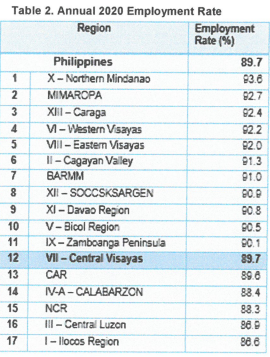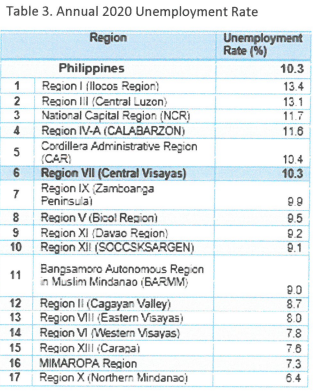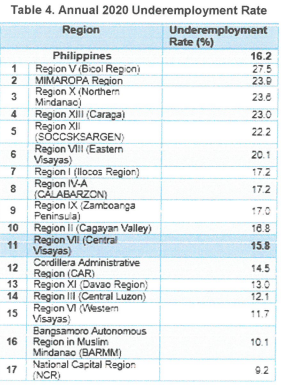The Labor Force Survey (LFS) is one of the nationwide household surveys undertaken quarterly which provides up-to-date information on the Philippine labor force and its characteristics. This survey gathers data on the demographic and socio- economic characteristics of the population and aims to provide a quantitative framework for the preparation of plans and formulation of policies affecting the labor market.
From the result of the Annual 2020 Labor Force Survey (LFS), Central Visayas has 5,433,000 total population of 15 years old and over wherein 58.7 percent were engaged in the Labor Force also known as the Labor Force Participation Rate (Table 1).

Labor Force Participation Rate is the percentage of the total number of persons in the labor force to the population of 15 years old and over.
The labor force population consists of the employed and the unemployed persons 15 years old and over.
The national employment rate for 2020 was estimated at 89.7 percent. Among regions Central Visayas had an employment rate of 89.7 percent which is the same with the national estimate (Table 2).

In 2020, workers were grouped into three broad sectors, namely, agriculture, industry and services sector. Workers in the services sector comprised the largest proportion of the population who are employed. It was followed by the agriculture sector and those in the industry sector are the smallest group.
Employed persons are classified as either full-time workers or part-time workers. Full-time workers refer to those who worked for 40 hours or more during the reference week, while those who worked for less than 40 hours were considered part-time workers. The reference week or reference period refers to the past seven days (moving) from the date of interview. This covers all persons 15 years old and over as of their last birthday.
Employed persons fall into any of these categories: (1) wage and salary workers, (2) self-employed workers without any paid employee, (3) employers in own family-operated farm or business, and (4) unpaid family workers. Wage and salary workers are those who work for private households, private establishments, government or government-controlled corporations, and those who work with pay in own family-operated farm or business.
Meanwhile unemployed persons include all those who, during the reference period, are 15 years old and over as of their last birthday who have no job/business, currently available for work and actively looking for work.
Also considered as unemployed are persons without a job or business who are reported not looking for work because of their belief that no work was available or because of temporary illness/disability, bad weather, pending job application or waiting for job interview.
The national unemployment rate in 2020 was estimated at 10.3 percent. Central Visayas had the same unemployment rate with the national estimate at 10.3 percent (Table 3).

By definition, employed persons who express desire to have additional hours of work in their present job, or to have additional job, or to have a new job with longer working hours are considered underemployed.
In 2020, the underemployment rate was estimated at 15.8 percent for Central Visayas. There are ten (10) other regions with higher underemployment rate compared to Central Visayas (Table 4).

Underemployed persons who work for less than 40 hours in a week are called visibly underemployed persons.
The Annual 2020 Employment, Unemployment, and Underemployment Rates were taken from the preliminary result of the annual estimates based on the average of the four quarter rounds of 2019 and 2020P LFS.
TECHNICAL NOTES
The annual labor and employment statistics presented in this release for 2019 used the average estimates of labor and employment indicators from the four Labor Force Survey (LFS) rounds conducted by the Philippine Statistics Authority (PSA) on a quarterly basis. The use of the average estimates of the four-quarter rounds of the LFS data was based on PSA Board Resolution No. 01, Series of 2017-151 - Approving and Adopting the Official Methodology for Generating Annual Labor and Employment Estimates, approved on the 14th day of February 2017.
For 2019, the methodology for annual labor and employment estimates uses the following formula to estimate employment, unemployment, underemployment and labor force participation rates: Zi= (∑j Xij / ∑j Ykj) x 100
where:
Zi = annual estimate for the rate of i where i refers to employment, unemployment, underemployment and labor force participation
Xij = estimate for the population of i for the jth round of LFS where
i refers to employed, unemployed, underemployed and labor force, and
j = refers to the four rounds of LFS: January, April, July and October
Ykj = estimate for the population of k for the jth round of LFS where
k = refers to labor force, employed persons and persons 15 years old and over, and
j = refers to the four rounds of LFS: January, April, July and October
The official methodology was deemed the most appropriate among methodologies reviewed and evaluated for the following reasons: a) it captures the labor and employment situation in all four quarters of the year; b) the generation or cross tabulations (e.g., by class of workers, by occupation group) is more feasible for producer of estimates; c) it is the closest method for estimating the number of persons who work four times for the entire year; and d) these estimates are being used by the Department of Labor and Employment (DOLE) and its attached agencies and regional offices for planning/formulation of intervention programs.
Approved by:
ARIEL E. FLORENDO
Regional Director

